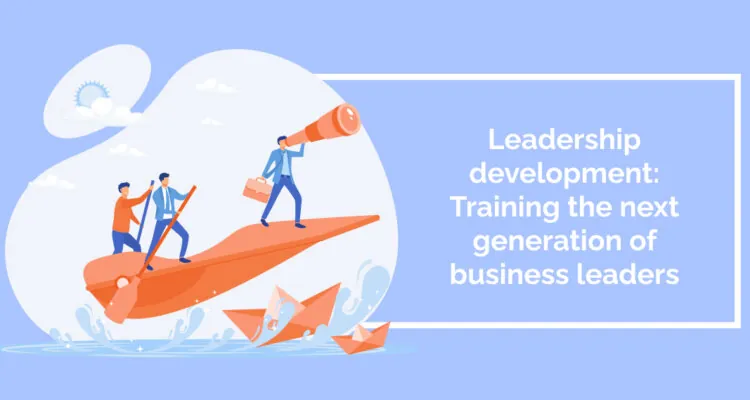
Developing staff for leadership positions isn’t a new practice, but the challenges it comes across don’t stay the same for long. For the next generation of leaders, the challenges are greater than ever: as Harvard’s 2023 leadership development survey highlighted, new managers have to be prepared for “continuous disruption” to their operations.
This article will help your company find the momentum it needs for leadership development today. It will:
- Define leadership development;
- Examine the best methods to deliver leadership development;
- Introduce some specific goals for leadership development.
As we’ll see along the way, elevating staff with a clear leadership vision has never been more difficult. But as we’ll see, the training developments of the 21st century have got what it takes to see your company through.
What is leadership development?
Leadership development is the systematic and intentional process of enhancing the skills, abilities, and qualities of individuals to prepare them for leadership roles within an organization or community. Not everyone can lead or manage people well. But with leadership training, companies support their staff to inspire, motivate, and lead teams or organizations towards achieving their objectives.
Good leadership development requires a significant investment in executive staff. Usually, the time and money are worth it for a number of reasons. Some goals of leadership development are:
- To help retain staff from within the organization, building retention, trust, and organizational culture;
- To improve a company’s reputation, and thereby make it easier to hire new staff;
- To reward long-standing staff with growth opportunities.
These goals are achieved through diligent leadership development programs.
Leadership development does not stay the same from decade to decade. Over the past century, theories of leadership have changed dramatically in response to changes in the economy, culture, organizational structure, and the nature of business itself.
Furthermore, methods of leadership development have themselves changed in line with educational advances. This means in-house training methods must adapt to the spirit of the time. In the next section, we’ll introduce some of the methods that are important today.
Methods for effective leadership development

There’s no doubt that leadership development is important. But just like any training task, there are many ways to achieve good outcomes for your leaders. To help you understand, this section will introduce a series of important leadership development methods.
They will include:
- Simulation training
- Job rotation
- Leadership coaching
- 360-degree feedback
- Classroom-based instruction
You might find some of these methods within many types of leadership development programs, whether that’s in-house training, occasional speaker series, or a third-party educational program. But if you’re seeking to improve your provision of leadership development, any of these tools can give you the progress you need to move forward.
Simulation training

In simulation training, leadership candidates act out high-risk situations in a controlled environment. They experience the dynamic challenges of decision-making, planning, and logistics, without putting company money on the line. Through these immersive spaces, candidates learn practical applications of their jobs.
How to implement simulation training
Today, there are many ways to implement simulation. Some of those methods include:
- In situ simulations
- Tabletop simulations
- Serious games
- VR simulations.
Some of these training solutions are, of course, very costly indeed – while others can be pursued on a fairly minor budget. So, it’s important to be strategic and careful about implementing simulation training, before you overspend and overdeliver.
Some key steps can include:
- Conduct a brainstorming exercise to figure out the best place to implement simulation training. This is a good stage to figure out whether you need to invest heavily in 3rd party tools, or whether your needs are satisfied with a more down-to-earth simulation exercise.
- Plan a series of meetings with all relevant stakeholders. If you can get everyone seated around the same table, you can be assured that all the leadership challenges will be represented appropriately.
- Ensure that you have trained people to support the simulation. Depending on the simulation tasks you have chosen, they may be facilitators, tech experts, or other support staff.
- After performing the exercise, conduct a review to see whether the learning objectives have been met.
Tips and techniques for success
Simulation training is a very broad category of training. When you’re planning simulations, think about the following tips:
- Many simulations demand a lot of input from stakeholders around the company. Make sure that you have efficient administrative processes to coordinate meetings, surveys, and the final training exercise.
- Simulations can cover a lot of high-stakes business situations, such as negotiation, decision-making, change management, and crisis handling. Simulations can support various outcomes: whether that’s the specialist knowledge for a niche situation or soft skills that you could apply anywhere.
- For leadership development purposes, simulations should fulfill an identified learning need. Simulations are often enjoyable, but they shouldn’t be treated as a break time exercise: If there is a simpler way of delivering the same need, choose that!
Who’s it for?
Simulations can benefit staff at all levels of a company. They can be a method for identifying leadership potential within a pool of staff, training the most advanced negotiation skills, or even assessing how well your leadership program participants are performing.
Job rotation

In job rotation, potential leadership candidates work in different roles in the workplace. You might have a full job rotation program, job shadowing, or some form of cross-training. When a candidate works in different positions in a company, they get a full view of the challenges and opportunities on the ground.
How to implement job rotation
Follow these steps to ensure effective job rotation in your organization:
- Identify the area of need: Assess the organization to pinpoint areas where job rotation could enhance skills, reduce monotony, or address manpower shortages.
- Choose the job rotation type: Select from options like cross-training, departmental rotation, or leadership rotation, depending on the goal (skill development, exposure, leadership training).
- Implement the program: Design a structured plan, clearly define roles, set rotation duration, and prepare employees for transitions.
- Monitor progress: Regularly track the program’s effectiveness, employee engagement, and skill development.
- Evaluate and adjust: Continuously assess outcomes against objectives, gather feedback, and make necessary adjustments for improvement.
Tips and techniques for success
If you’re considering using job rotation, think about the following tips:
- Emphasize thorough planning: Stress the importance of meticulous planning for a successful job rotation program. Ensure a dedicated individual or team is responsible for overseeing and coordinating the entire process.
- Leverage workforce planning software: Use specialized software tools to leverage workforce planning software, manage schedules, track skill sets, and ensure efficient coverage of all critical roles throughout the rotation period.
- Set clear expectations: Communicate to employees that job rotation is not a break from work. Communicate to employees that we expect the same level of commitment and productivity as in their regular roles.
- Monitor workload and performance: Regularly assess the workload and performance of rotating employees to ensure they are contributing effectively and not being overwhelmed.
Who’s it for?
Job rotation can work for any type of leadership development. However, in white-collar companies, it is commonly connected with high-potential candidates. So, graduate recruits and senior executive positions alike would benefit significantly from a job rotation scheme.
Leadership Coaching

Coaching helps individuals to build their skills, self-awareness, and overall effectiveness through a personalized and collaborative process.
A skilled coach works closely with a leader, providing guidance, support, and constructive feedback to help them navigate challenges, set goals, and unlock their full potential.
Coaching addresses specific leadership needs, cultivates strategic thinking, and fosters a deeper understanding of one’s strengths and areas for improvement. This one-on-one interaction not only accelerates personal and professional growth, but also empowers leaders to apply newfound insights directly to their roles, contributing to positive organizational outcomes.
How to implement it
By following these steps, organizations can establish a practical and effective leadership coaching program:
- Start by finding trained coaches, whether from internal resources or external experts. Look for individuals, preferably experienced staff, who understand the process of setting and achieving goals. Coaches must possess the expertise to guide leaders effectively in their development journey.
- Take the time to thoughtfully match coaches with leaders undergoing training. While it may seem straightforward, ensuring a good fit between coaches and leaders is essential.
- Consider factors like coaching style, industry knowledge, and the specific needs of each leader to maximize the effectiveness of the coaching relationship.
- Put in place a structured communication system to facilitate seamless interactions between coaches and leaders. Regular meetings to discuss progress, challenges, and adjustments are essential. Open and fluent communication ensures that leaders receive the necessary support and guidance throughout the coaching process.
- Finally, consider how the coaching program integrates with broader training initiatives. Explore ways to give credit for coaching participation and link it to other feedback mechanisms within the organization. This integration not only enhances the overall impact of leadership development, but also provides a cohesive learning experience for participants.
Tips and techniques for success
Coaching is a great way to develop leaders if you have the right infrastructure in place. Keep these tips in mind if you’re thinking of implementing coaching:
- Coaching takes a serious investment of energy from mentees and coaches alike. Your participants must have the disposition, motivation, and time, to make the most out of this opportunity. Indeed, some people say that coaching should only ever be voluntary since it takes such a personal approach.
- It should go without saying that an individualized approach is at the core of what coaching does. So, tailor coaching sessions to the unique needs, strengths, and challenges of each leader.
- Recognize that leadership styles vary, and a one-size-fits-all approach may not be effective. By understanding the specific goals and aspirations of each individual, coaching can be more targeted and impactful.
- The question of impact is a bit more complex in coaching than other programs. Coaches may make a holistic change to a mentee’s working practice, which can be hard to quantify.
- When you’re gathering employee feedback on the coaching program, make sure that they have plenty of space to talk about their subjective experience.
Who’s it for?
Coaching in leadership development is particularly crucial for three key categories of participants.
- Firstly, it proves highly beneficial for emerging leaders and high-potential talents, guiding them through challenges and accelerating their leadership growth.
- Secondly, leaders operating in fast-evolving situations or industries find coaching invaluable for developing adaptive skills essential for navigating uncertainty successfully.
- Lastly, coaching is instrumental for leaders undergoing career transitions, providing support in managing complexities, setting new goals, and aligning strategies with the evolving professional landscape.
In these scenarios, coaching offers personalized guidance tailored to individual needs, fostering leadership excellence.
360-degree feedback

360-degree feedback is a comprehensive performance assessment tool. Feedback is collected from multiple sources, including the leader’s superiors, peers, subordinates, and sometimes even external stakeholders or customers.
This holistic approach provides a well-rounded and detailed evaluation of a leader’s skills, competencies, and interpersonal effectiveness. The feedback typically covers a range of leadership dimensions, such as communication, collaboration, decision-making, and overall leadership style.
How to implement 360-degree feedback
With a few simple steps, organizations can leverage the power of 360-degree feedback to enhance leadership skills, foster self-awareness, and ultimately cultivate exceptional leaders who make a lasting impact on their teams and organizations.
Get started like this:
- Start by setting goals for the feedback exercise. Feedback is most useful when it is focused and structured. Participants and evaluators alike need clear goals, otherwise they won’t be sure how to improve.
- Identify all relevant stakeholders for developing the leadership skills of each participant.
- Decide what you expect participants to do once they have received their feedback. It might form part of goal-setting in a regular performance review, or it might be a summative statement that assesses the strengths and weaknesses of each aspiring leader.
Tips and techniques for success
360-degree feedback takes a bit of care to get right – especially if you are setting it up for the first time. Think about the following tips if you want to start on a firm foundation:
- Choose your participants strategically. Delivering extra feedback can be demanding on staff who are already busy with their work. With so many competing claims on managers’ attention, make sure that they have enough time to feedback effectively.
- Ensure good oversight for the feedback program. You may find that an external coaching provider can give you the direction you need at every stage.
- With so much feedback, the leader-in-training may be confused about their priorities. However the feedback arrives, whether through a survey or written comments, make sure the subject has time to discuss the results with a relevant member of staff.
Who’s it for?
In the context of leadership development, 360-degree feedback is most valuable for people who have already established themselves in a career trajectory. Mid-level managers and above will especially appreciate the input of 360-degree feedback.
Classroom style programs

In some cases, aspiring leaders need old-fashioned classroom instruction. Although there’s no subject for hands-on learning, many industries expect that their leadership team has excellent knowledge in all relevant areas.
Today, that might include:
- How digital transformation can impact ROIs;
- How to implement change management projects effectively;
- Working with cross-functional teams;
- When to use agile leadership techniques.
In a classroom setting, executive candidates may learn through the analysis of case studies, individual coursework assignments, and collaborative learning exercises. They will still need to prove themselves in the workplace. But for many people, knowledge itself can be an asset to lead a team.
How to implement classroom-style programs
You have several choices for implementing a classroom-style program:
- Organize a series of workshops within your company. You can make use of internal and external speakers to introduce the most important topics. In between sessions, participants can undertake background reading to improve theory understanding.
- Set up a leadership development away day, – involving a mix of lectures, analysis, and group work. Create a focused learning environment by organizing off-site events that incorporate a diverse mix of traditional lectures, interactive analyses, and engaging group activities. These away days support concentrated learning while enhancing team building and collaborative problem-solving.
- Work with third-party training providers to deliver training modules. Many leadership challenges cut across different companies and sectors – so there’s no harm in using a generalist provision to address the general needs of your upcoming leadership team.
- In some cases, a postgraduate leadership qualification might be the most appropriate course of action. This investment is justified when an advanced degree significantly contributes to the leader’s ability to drive innovation, navigate complex challenges, and enhance the overall competitiveness and success of the organization.
Tips and techniques for success
Although “traditional” methods of instruction have got a bit of a bad name, they can give participants a unique opportunity to understand their context. To make the most of this chance, think about the following tips:
- Classroom instruction is a great opportunity to balance tailored learning needs and generic leadership skills. You can choose modules and assignments that meet the needs of your cohort, or introduce overarching skills that would be important for any leadership position.
- Digital tools can be a vital tool in this work. If you are planning to go further with didactic instruction, an adaptive learning platform can be a very positive investment.
- The routine of instruction and assignment gives many opportunities for a positive feedback loop. As your staff climb higher up the career ladder, feedback is hard to come by. This is a rare opportunity to step back and reflect on the things that matter.
Who’s it for?
This approach benefits individuals at many levels of leadership. For employees early in their careers, this may be a great chance to let their interest in leadership shine. For senior executives, this is the moment to get advanced specialist skills.
Business use cases for leadership development
Leadership development is an integral aspect of organizational growth aiming to enhance people management while aligning with individuals’ strengths. As a result, theories of leadership development address generic situations rather than specific goals or programs.
However, sometimes a more focused and tailored approach becomes essential. In this section, we’ll take a look at three targeted areas. They are:
- Succession planning, which ensures comprehensive coverage of critical leadership positions;
- Development for well-being, emphasizing the intersection of leadership skills with individual and organizational health;
- Collective leadership development, which integrates general leadership skills with task-specific approaches.
In these specific domains, the emphasis is on combining foundational leadership skills with task-specific strategies for more effective and targeted development.
Succession planning
One critical business use case is succession planning, a meticulous process ensuring the coverage of every leadership position within a company. This strategic approach, highlighted as a “natural ally” of leadership development in a classic HBR article, particularly emphasizes the most pivotal leadership roles that a company cannot function without.
While the methods mentioned earlier prove useful, the success of succession planning is enhanced through:
- Being transparent about the process. Inevitably, one leader may be groomed for success while another is not: and that needs to be clear from the start.
- Vigilant performance monitoring. If you already have expectations for a particular leadership position, it will be easier to measure up potential candidates.
- Tailored programs. Such programs extend beyond skill acquisition, delving into sector-specific knowledge crucial for these key roles.
Some organizations can rely on a pervasive learning culture to fill future vacancies. However, enterprise-level companies find that intentional investments in succession planning are indispensable.
Development for well-being and engagement
Leadership development can emphasize different aspects of company life. One of the areas that’s most important to develop in 2024 is well-being and engagement.
Leaders may have the best intentions for employee wellbeing when they receive a promotion, but the pressures of a new role may mean they forget about how to look after their staff.
If your company needs to develop leaders who can improve overall well-being, any of the methods outlined above could be useful. But consider the following points:
- Engagement and well-being are not just about soft skills, although these all help. Leaders also need to know about the problems, solutions, and implementations that really make a difference. So while simulation training could give leaders hands-on practice to help make the best decision, some elements of classroom instruction could also improve leaders in this area.
- Most companies can do better when it comes to wellbeing: but almost every company has something to be proud of. So when you’re trying to develop leaders with an emphasis on wellbeing, make sure you build on existing strengths. Perhaps your best leaders already have a clear understanding of best practices in the organization.
- Finally, you should be proud of a program like this. Junior staff and senior executives alike should be able to understand the benefits of this kind of program. And they should be able to weigh up whether or not they are seeing the benefits!
For more information, the CIPD’s excellent toolkit provides a lot of information about developing managers in this sphere.
Collective leadership development
Collective leadership development improves leadership capabilities across an entire team. Instead of focusing on individual leaders, collective leadership development recognizes the importance of fostering leadership qualities at various levels and across different functions within a team or organization.
This approach aims to create a shared leadership culture, where team members collaboratively contribute to achieving common goals. Some formats we’ve outlined above will still apply to this. However, they must be adapted to suit widespread participation and engagement.
Group-based learning and collaborative training methods could underpin this element of organizational culture. Collective leadership development encourages a sense of shared responsibility, collaboration, and a unified commitment to the organization’s success.
Thoughts for the future of leadership development
As we mentioned at the start of the article, the big challenge for leadership of the future is the unknown. We simply don’t know what the biggest challenges will be. However leadership development programs deserve a prominent place.
It will pay dividends if staff engaged in any kind of leadership activity are well-versed in relevant managerial theory – whether that’s transformational leadership, servant leadership, or other industry-specific best practices.
Leadership development should not just be for the top dogs of the C-suite. As McKinsey’s analysis points out, CEOs in 2024 should put more effort into appreciating middle management. Besides recognition, development programs could be a way to meet organizational challenges moving forward.
The business case studies of the past can still inform the choices of the future, even if they cannot guarantee certainty.
It’s a tough world out there. With a solid leadership development program in place, your business will be in a far better position to weather the storm.
WalkMe Team
WalkMe spearheaded the Digital Adoption Platform (DAP) for associations to use the maximum capacity of their advanced resources. Utilizing man-made consciousness, AI, and context-oriented direction, WalkMe adds a powerful UI layer to raise the computerized proficiency, everything being equal.



